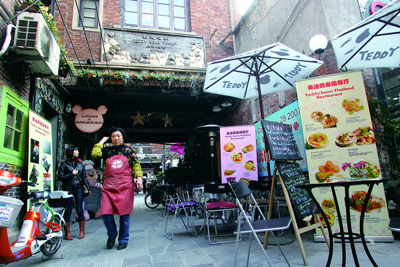"Though it doesn't look as neat and tidy as Xintiandi or M50, it reflects the true life of old Shanghai," said Li Jialing, a fashion designer who runs the Feel Shanghai studio in the area.
|

|
| Teddy Bear Thai Restaurant. |
"Disorder -- maybe that's not quite the right word -- is the biggest charm here."
Elyse Singleton, an Australian expat, enjoys the area's human scale in a city packed with malls and skyscrapers.
"I also love the fact that you can find independent designers and one-off boutiques and cafes that you can't find anywhere else in the city," she said. "I also love the atmosphere -- cafes with alfresco dining, narrow alleyways, creativity..."
For the artists, craftspeople and shop owners, one of the chief attractions is the availability of small studios at relatively low cost, especially compared with the M50 art complex in the Moganshan area and the Xintiandi entertainment complex, where rents are stratospheric.
A typical studio off Taikang Road is 20 to 30 square meters and rents for around 3 yuan (US$0.41) per square meter per month. Rents are higher at M50 because the studios are much larger, and in Xintiandi, the price is US$25 to US$35 per square meter per month.
"Not many artists in Shanghai can afford the cost of running a studio over 200 square meters; that's why some artists move here from M50," Wu said. "That's the major reason for the success of Taikang Road — it is small and unique."
As quickly as the area has grown since 2004, even more rapid expansion is on the horizon. The number of studios is expected to triple to more than 700 over the next two years as the project expands west to Ruijin Road. At that time, the floor area of the stores will comprise 75,000 square meters, surpassing the scope of Xintiandi. The Luwan District government will become more involved in the Taikang Road project and set up a formal administration office next year, according to Wu.
"In two years, we can compete with Xintiandi, with our unique feature being the sense of community life," Wu said.
Though rising property values are causing some residents to move out, Wu intends to maintain his main selling point by zoning off some areas from commercial development. The better-maintained homes, especially those with indoor toilets, will not be rented out. And some rooms on second and third floors that are difficult to lease will be renovated into family hotels.
"The principle is to not allow develop-ment to ruin the original atmosphere," he said.
That may be easier said than done, given the development arc that typically occurs in areas where struggling artists draw a crowd -- witness New York's SoHo and countless other places that have been transformed by gentrification.
Said renowned photographer Deke Erh, whose studio has long been a tenant of Lane 210, "Art doesn't exist only in the national museum or in galleries. Art is everywhere, and Taikang Road proves it. My worry is that rents might rise so high than artists can't afford to stay here."
(China Pictorial March 4, 2009)